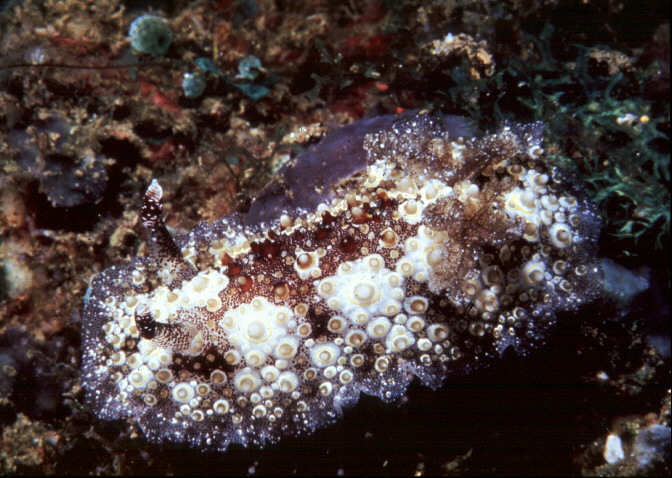 |
Hoplodoris estrelyado
Hoplodoris estrelyado Gosliner & Behrens, 1998
Ever since webmaster Mike collected and photographed the first specimen of this new species in Batangas Province, our gang has referred to it as the Fried Eggs dorid. The unique color pattern of H. estrelyado, also caught the eye of Charles Anderson in the Maldives, where he thought the notal color pattern looked like daisies and daubed it the "Daisy" dorid. This eye catching pattern is the derivation of our nominated species name "estrelyado." Estrelyado is actually the Tagalog word for "sunny side up" which is derived from the Spanish word "estrella," for star, indicating the eggs are formed into star-like patterns with the yolk facing upwards. To make a long story short, Terry and I thought that the color pattern on the dorsal surface of this beast looked like fried eggs, served sunny-side up.
Not only does the color look like a fried egg, but the tubercles covering the dorsal surface are tall and shaped like plump perfectly prepared fried eggs. The remainder of the dorsal surface is speckled with the white and black of scattered salt and pepper served with this dish. Okay, enough of the food thing, the rhinophores and gills look nothing like food, are typically dorid in shape, and are dark brown with white specks.
Our specimens reached 40 mm in length, and were collected in waters to 30 m deep. We know of this species from Vietnam and Western Australia from Debelius (1996), page 253, two lower photos miss-identified as Hoplodoris nodulosa, a closely related species, and from Indonesia, the Philippines and Marshall Islands.
The anatomy of the type species of Hoplodoris want never completely described, making placement of estrelyado into this genus difficult. Since the description of the genus by Rudolph Bergh in 1880, several authors have wrestled with what to do with individual species placed here. For now, we feel Hoplodoris is the best fit for this species, but we too await the efforts of some brave soul in a sorely needed, careful review and revision of the entire cryptobranch dorid complex.
The characteristics which distinguish Hoplodoris estrelyado from other members of this genius, and of the closely related genus Carminodoris, and especially Hoplodoris nodulosa, are primarily internal. These include the lack of armature on the penis and vestibular glands, both of which is present in H. nodulosa.
Citation
Terrence M. Gosliner and David W. Behrens. 1998.Two New Discodorid Nudibranchs from the Western Pacific with a Redescription of Doris Luteola Kelaart, 1858. Proceedings of the California Academy of Sciences, 50(11): 279-293, 7 Figs.
Taxomonic information courtesy of Dave Behrens

David W. Behrens
Author:
Pacific Coast Nudibranchs
Send Dave mail at seachalleng@earthlink.net
|
© The Slug Site, Michael D. Miller 1998. All Rights Reserved.
